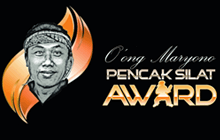Pencak silat is a unique form of martial arts rooted in Malay culture, which stretches across Indonesia, Malaysia, Singapore, Brunei Darussalam, the Southern Philippines and Southern Thailand, and other places where populations who converse in the Malay language and refer to a common Malay ancestry can be found.
Its name was devised by the Indonesian Pencak Silat Association (Ikatan Pencak Silat Indonesia or IPSI), which was established in 1948 in Solo, Indonesia and later adopted by the International Pencak Silat Federation founded in 1980 by Indonesia, Malaysia, Singapore, and Brunei Darussalam and is now used by all its members spread around the globe. More specifically, the term “pencak silat” is a compound name formed by linking two root words used with their derivatives in different parts of Indonesia in order to unify a great number of martial arts schools and styles spread across the archipelago. The word “pencak” and its dialectic spinoffs such as “penca” (West Java) and “mancak” (Madura and Bali) is commonly used in Java, Madura, and Bali, whereas the term “silat” or “silek” is used in Sumatra (along with “gayung”). These and many other variations are still very much alive locally today.
Nomenclatures also vary regionally. Malaysia, Singapore, Brunei, and Southern Thailand employ “silat” to refer to martial arts techniques and “bersilat” for the practice of it. Other names, depending on places of origin or techniques, include “gayong,” “gayong Fatani,” “lintan,” “cekak,” and “keletan.” The Philippines also uses “pasilat” in addition to “silat.”
This multitude of terms expresses an incredible richness of meanings and techniques, although they all refer to one specific form of martial art with a shared heritage and specific pattern. Pencak silat arrangements combine sport and self-defense moves with artistic elements, as well as breathing and spiritual awareness. According to IPSI, pencak silat is essentially the totality of four aspects or four appearances integrated in a unity—four in one—as represented by the trident in the IPSI logo, where the three blades represent the elements of art, self-defense, and sport, and the handle represents the mental-spiritual aspect.
As an art (seni), pencak silat is performed to celebrate the beauty of movement. Pencak silat seni expresses cultural values in the form of patterns of movement and rhythm, which involve harmony, balance, and the accord of gracefulness, rhythm, and feeling. In some regions, artistic moves are accompanied by special percussion instruments and are performed at social events, such as harvest festivals, marriages, and public gatherings.
As a form of self-defense (bela diri), pencak silat is performed to heighten the human instinct to defend oneself against any kind of threat and danger. To this end, the tactics and techniques that the pencak silat practitioner (pesilat) uses emphasize his physical safety and, if necessary, attacking the opponent first.
Likewise, as a sport (olah raga), pencak silat prioritizes physical skills to attain fitness, dexterity, and endurance. When training, a pesilat (practitioner of pencak silat) strives to enhance the agility of the body and to make more forceful maneuvers, while gaining confidence in order to perform well in sport competitions.
As a spiritual exercise (olah batin), pencak silat focuses more on shaping the individual bearing and character of the pesilat as befitting its spiritual philosophy. It places equal emphasis on controlled physical movements, inner power, and observance of the core value of nobleness of mind and character (keluruhan budi pekerti).
These four aspects combine in the specific movements of pencak silat, which consist of several key components or basic techniques. In general, we can differentiate four kinds of basic techniques: initial stance, footwork, offensive techniques, and defensive techniques. By assuming an initial stance (standing position), the pesilat shows that he/she is ready and on guard. This could switch at any time to a particular tactical move. Normally both legs and arms are employed in this stance, which may involve standing, crouching, sitting, or lying down.
If initial stances are the static part of pencak silat, the footwork is its dynamic part. By determining the direction, type, and tactic of the maneuver, the pesilat moves to defend or attack. More specifically, defending oneself involves taking action to evade attack from an opponent (using defensive, evasive, and disengaging techniques for instance). Offensive action involves trying to bring down the opponent in a number of ways, such as punching, kicking, and grappling. These defensive and offensive techniques also make use of several kinds of weapons, such as knives, swords, trisula (tridents), and toya (wooden staffs usually of rattan).
Somehow paradoxically, the unified pencak silat pattern is constituted from a great range of variation in how the basic moves and techniques are combined, and depending on which key aspect within this combination is being emphasized. Different masters and their students have created their own styles according to their preferences and to the physical environment and social-cultural context wherein they live, resulting in hundreds of schools and styles. This makes pencak silat a rich cultural phenomena, fascinating to practice and study.

